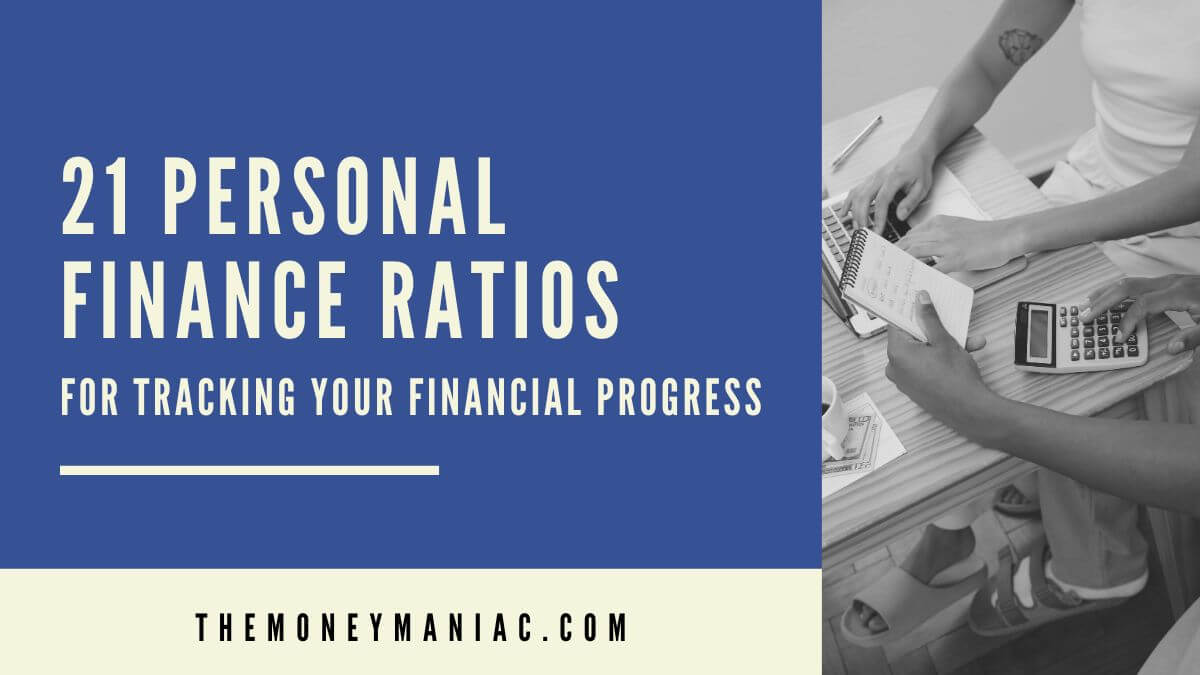Could you survive an unexpected job loss? Do you know when (or if) you can retire? Is your housing too expensive? Your personal financial ratios can provide these answers.
These simple yet powerful formulas will give you a deeper understanding of your financial well-being. And they can quickly identify financial trends in a way not possible by just reviewing your account statements.
This article will show you the 21 most important personal finance ratios you need to track your financial progress and take control of your money. Besides learning how each one works, you will also see how easy it is to start applying them today.
After all, when it comes to money, it’s not how much you make — it’s how much you keep and what you do with it that really matters.
What Is A Personal Finance Ratio?
A ratio provides a comparison between two numbers. And since we’re talking about finance, we’re talking about money.
More specifically — YOUR money.
Just like a doctor takes your blood pressure, temperature, and pulse to determine the state of your health, your personal finance ratios are the barometer that measures your financial health.
Think of them as a way to track your money and how you’re using it. By watching how they change over time, you can measure your progress, celebrate milestones, and identify areas that need attention.
21 Personal Finance Ratios Everyone Should Know
No matter your goal — building an emergency fund, paying off debt, or reaching financial independence in the next ten years — these personal finance ratios are the compass that keeps you confidently heading in the right direction.
1. Emergency Fund Ratio
Formula: Monthly non-discretionary expenses x 6 months
According to a recent Bankrate survey, 57% of Americans couldn’t pay a surprise $500 expense from savings. An emergency fund provides a cushion in case the unexpected pops up, like an unforeseen car repair or medical emergency.
Most financial experts recommend setting aside 3 to 6 months of non-discretionary expenses — rent, utilities, groceries, and debt payments — in a high-yield savings account. However, if you’re self-employed or your income varies each month, consider increasing this to 12 months.
2. Liquidity Ratio
Formula: Total cash and cash equivalents ÷ monthly non-discretionary expenses
Cash equivalents are short-term investments that can be easily converted into cash. These include:
- High-yield savings accounts
- Short-term CDs
- Money market funds
- Short-term government bonds
Your liquidity ratio is closely tied to your emergency fund ratio because both of these personal finance ratios highlight your downside protection. But the liquidity ratio, in particular, shows you how many months of expenses you could cover if you lost your job.
Ideally, your liquidity ratio should fall between 3 and 6. If yours is less than 3, make savings your top priority.
3. Budget Ratio
Formula: Depends on the budget
A budget provides the necessary structure to reach your financial goals. It breaks down your spending by category, so you can take control of your money rather than letting it control you.
More than just expenses, a good budget also focuses on savings and investments. Two popular options are the 50-30-20 and 30-30-30-10 methods.
Popularized by U.S. Senator Elizabeth Warren, the 50-30-20 budget recommends devoting 50% of your income to essentials (including housing), 30% to fun, and 20% to savings.
And for those looking to boost their savings, the 30-30-30-10 budget proposes 30% for housing, 30% for essentials, 30% for savings, and 10% for fun.
4. Personal Cash Flow Ratio
Formula: Monthly post-tax income – monthly expenses
Cash flow is what you have left over after paying for your monthly expenses. A positive cash flow signifies that you are living within your means. On the other hand, a negative cash flow means you are using debt to subsidize your lifestyle.
If you want to increase your cash flow, you have two options: cut back on expenses or increase your income. We at The Money Maniac are partial to the latter, knowing that every dollar you earn goes directly toward boosting your cash flow ratio.
5. Savings Ratio
Formula: Monthly savings rate ÷ monthly post-tax income
Whether building an emergency fund or saving for a down payment on a house, your savings rate is how much money you are setting aside each month in a cash account, like a high-yield bank account.
At a bare minimum, you should save at least 10% of your monthly income (though 20% would be better). And if you are struggling to hit this mark, check out these creative ways to start saving today.
6. Net Worth Ratio
Formula: Total assets – total liabilities
Your net worth is like your personal balance sheet. It provides a snapshot of your financial strength at a moment in time. And for that reason, it is one of the most popular personal finance ratios to track.
To calculate your net worth, add up all of your assets based on their current market values. These include savings, investments, retirement accounts, your home, and automobiles.
Then, subtract all of your liabilities — credit cards, mortgages, student loans, and other debts — from your total assets. What’s left is your net worth.
Typically, this number is low when you are starting out (or even negative if you just graduated). But you can steadily increase it over time by building your assets and reducing your debts.
7. Targeted Net Worth Ratio
Formula: Age x (pre-tax income ÷ 10)
Made popular in the book, The Millionaire Next Door, your targeted net worth provides a benchmark of where your net worth should be based on your age and income.
For example, if you are 25 years old and making $50,000 per year, this ratio suggests that you should have a net worth of $125,000. However, if you are 50 and making $100,000, then it should be $500,000.
Keep in mind that this is just a guideline. But it can give you something to strive for if you enjoy numerical goals.
8. Savings To Net Worth Ratio
Formula: Total savings ÷ net worth
This ratio measures how much you have in savings (cash and cash equivalents) compared to your net worth. The higher the percentage, the bigger the financial buffer you have if you were to suffer an unexpected job loss.
However, if this number is too high, you could be missing out on potential growth opportunities that other assets provide.
Maintaining up to 15% of your net worth in savings is a good rule of thumb. If you’re higher than that, consider putting some of your cash in more aggressive investments.
9. Net Invested Assets To Net Worth
Formula: Total invested assets ÷ net worth
While the savings to net worth ratio measures your financial cushion, this ratio measures how much of your assets are working for you.
To calculate your net invested assets to net worth ratio, divide the total of all your investments (including any retirement accounts but excluding your house) by your net worth.
For example, if you have investments of $150,000 (excluding your primary residence) and a net worth of $250,000, your ratio would be 60%. This means that 60% of your assets are busy creating more wealth for you.
Typically, a ratio over 50% is considered healthy. But more importantly, you want to see it trending higher as you build up your portfolio.
10. Debt To Assets Ratio
Formula: Total liabilities ÷ total assets
Commonly used by analysts to gauge a company’s leverage, this ratio helps to determine if a person’s debt load is too high.
The higher the ratio, the greater the risk of insolvency since you may not have enough assets to pay your debts in the event of an unexpected emergency.
Try to keep your ratio below 50%, and decrease it over time as you pay off loans and build your assets.
11. Total Debt Service Ratio
Formula: Total monthly debt payments ÷ monthly post-tax income
The debt service ratio shows how much of your take-home pay goes toward debt payments. A high ratio means you have less discretionary income for living expenses and investments.
A good rule of thumb is to keep this ratio under 35%, including your mortgage payment.
If your ratio is higher than that, look for ways to reduce your debt load. One option is to consider a less expensive car, and another is to allocate more of your budget toward accelerating debt repayment.
12. Solvency Ratio
Formula: Total net worth ÷ total assets
Solvency refers to your ability to keep making debt payments even if you had a sudden loss of income.
This ratio measures your solvency by taking your net worth (total assets minus total liabilities) and dividing it by your total assets. And the higher the ratio, the better your financial health because you have more assets relative to your debt.
For example, if your net worth equals your total assets that indicates that you have no liabilities. So you would have a ratio of 1. In the case of a financial emergency, you could use your assets to cover your living expenses rather than having to juggle loan payments.
On the other hand, a low ratio could indicate a greater risk of bankruptcy. If you lost your income, you may find yourself in a situation where you don’t have enough assets to continue making your debt payments and covering living expenses.
13. Basic Housing Ratio
Formula: Housing costs ÷ pre-tax income
This is one of the most widely used personal finance ratios by lenders. Mortgage providers often use this formula to evaluate how much home you can afford.
Housing costs are defined as your mortgage payment plus taxes and homeowners insurance. And by comparing this sum to your gross monthly income, lenders can determine if the home you’re considering is within reach.
Housing experts recommend a ratio of 28% or less. However, a ratio as high as 33% isn’t uncommon for homeowners living in high-cost cities.
14. Broad Housing Ratio
Formula: (Housing costs + other debt payments) ÷ pre-tax income
Also known as your debt-to-income ratio, lenders use this ratio in addition to your basic housing ratio to determine your home buying power.
Even if your basic housing ratio is in line with lender guidelines, if your debt-to-income ratio is too high, it could disqualify you from the purchase altogether.
Experts recommend keeping this ratio under 36%. A ratio of over 38% is considered excessive and should be reduced before applying for a mortgage.
15. Return On Investment Ratio
Formula: (Ending investments – contributions – beginning investments) ÷ beginning investments
How well are your investments doing? Use this ratio to quickly calculate your portfolio’s performance during any given time period.
Just subtract the beginning balance from the ending balance, less any contributions made in between. Then, divide the result by your beginning balance, and you will have your return on investment.
For example, let’s say at the end of the year your retirement portfolio is worth $50,000. You started the year at $40,000 and made $5,000 in contributions.
Using the formula ($50,000 – $5,000 – $40,000) ÷ $40,000, your return on investment was 12.5%.
You can use this ratio for your entire portfolio or individual assets.
16. Investment Assets To Gross Pay Ratio
Formula: (Investment assets + cash) ÷ annual gross pay
Most financial experts recommend building a portfolio worth 25 times your annual income before retiring, if you want to maintain your current lifestyle.
While this target may be fine for someone who is spending most of what they make, it could be overkill for those who have been saving and investing heavily. In that case, you could get away with 15 to 20 times your income.
This formula quickly measures your progress toward that goal. A ratio of 1 means you have enough money to replace one year of earnings. And a ratio of 15+ means you are nearing financial independence, and being able to potentially sustain your lifestyle without needing to work.
17. Your Current Ratio
Formula: Cash assets ÷ short-term liabilities
The current ratio measures your ability to meet short-term obligations from cash and is a key indicator of your financial health.
Short-term liabilities are all of your loan payments coming due within the next year, including your mortgage. This ratio highlights your ability to pay off those debts without having to sell investments.
For example, if you have a car payment of $200 a month with a balance of $10,000, you would include $2,400 (12 x $200) in your short-term liabilities.
A current ratio greater than 1 means you have more than enough cash to cover your debt for the next 12 months.
18. Cost Of Debt Ratio
Formula: (Loan 1 ÷ total debt) x (interest rate for loan 1) + (loan 2 ÷ total debt) x (interest rate for loan 2)
Don’t let high-interest rates sabotage your financial plans. The cost of debt ratio reveals the average interest you are paying across all of your debts.
To calculate it, take a weighted average of the interest rates on all your outstanding loans.
Let’s look at an example using the following liabilities:
Car loan: $20,000 at 8%
Credit card: $15,000 at 18%
Student loan: $25,000 at 6%
The total debt equals $60,000. Using the formula, we can now calculate the average interest paid across all loans.
($20,000 ÷ $60,000 x .08) + ($15,000 ÷ $60,000 x .18) + ($25,000 ÷ $60,000 x .06) = .097 or 9.7%.
Be sure to keep your average interest rate well below the rate of return on your investments. If it’s higher, focus on paying off your high-interest-rate debt right away.
19. Passive Income Ratio
Formula: Passive income ÷ total income
Rather than trading time for money, passive income is all about doing the work once and getting paid multiple times. The goal is to receive an ongoing income stream with little to no ongoing effort.
This ratio measures how much of your income comes from passive sources, like dividends, affiliate marketing, or real estate.
The quicker you can increase this ratio, the less dependent you will be on your day job to pay for your living expenses.
20. Life Insurance Ratio
Formula: Primary income x 10
Use this ratio as a starting point to determine your life insurance needs. For example, if you make $50,000 per year, you would need $500,000 in coverage.
However, this amount could be excessive for a DINC (dual income no children) couple.
On the other hand, if you are the primary wage earner for a family with three small children, it may not be enough. In that case, consider using a factor of 15 or 20 to ensure that it will cover all household bills and potential college expenses.
But as your assets grow, you may choose to reduce this coverage. Once the kids are out of school, consider carrying just enough insurance to pay off all your debts, including the mortgage, with a little extra for miscellaneous expenses.
21. Retirement Savings Ratio
Formula: 25 x annual expenses
Oh, to retire early! The goal of many of our readers at The Money Maniac. This is the magic number your portfolio needs to reach so you can finally quit the 9-to-5 grind and start enjoying financial independence.
With several FIRE options to choose from — Coast, Barista, Fat, and Lean — how you determine your expenses will be based on your personal goals and preferences.
Whether you want to live frugally to retire earlier or are willing to work longer to enjoy a luxurious retirement, you can finally toss the alarm clock for good once you accumulate an investable net worth of 25 times your desired annual expenses.
How Often Should I Check My Personal Finance Ratios?
Most companies provide financials every quarter, but that may be excessive on a personal level.
Instead, keep a close eye on certain ratios, like the budget, liquidity, and emergency fund ratios. You may even want to check those monthly!
But most others can be reviewed every six to twelve months since they won’t change as rapidly. Net worth, return on investment, and your FIRE number all fit into this latter group.
Final Thoughts
Knowing your personal finance ratios goes a long way toward reducing stress and providing peace of mind.
By reviewing them regularly, you can not only track your progress but also see areas where you’ve gone astray. This makes correcting course and adjusting your budget much easier.
Think of these ratios as your financial GPS. They will keep you headed confidently toward your final destination — financial independence.



